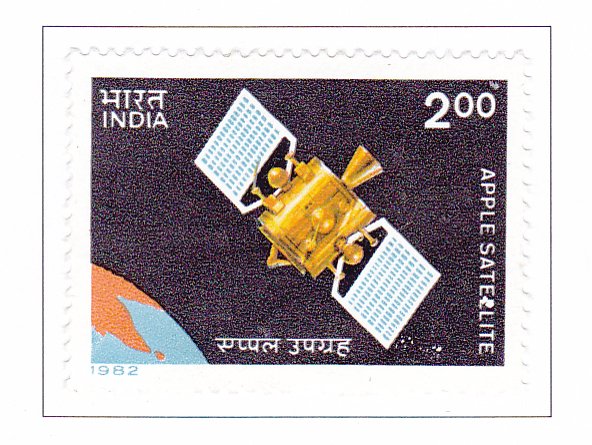1st Anniversary of “Apple Satellite” Launch

Technical Data
| Date of Issue | June 19, 1982 |
|---|---|
| Denomination | Rs. 2 |
| Quantity | 2,000,000 |
| Perforation | comb 13½ x 13 |
| Printer | Security Printing Press, Nashik |
| Watermark | No Watermark |
| Colors | Multicolor |
| Catalog Codes |
Michel IN 912 Stamp Number IN 963 Yvert et Tellier IN 723 Stanley Gibbons IN 1047 |
| Themes | Anniversaries and Jubilees | Satellites | Spacecraft |
The successful launch of APPLE Satellite (Airline Passenger Payload Experiment), India’s first three-axis stabilized experimental communication satellite, using the ARIANE launcher on June 19, 1981, represents a significant milestone in India’s space program. By positioning the APPLE spacecraft in the three-axis stabilized mode in the geostationary orbit at 102°E longitude on July 16, 1981, after executing complex mission maneuvers, India joined the ranks of nations that have developed their own three-axis stabilized stationary communication satellites.
With a launch weight of 673 kilograms, APPLE has a cylindrical structure with a diameter of 1200 millimeters and an overall height of 1985 millimeters. The spacecraft was designed and developed at the ISRO Satellite Centre (ISAC) of ISRO in Bangalore. ISAC was responsible for the overall management, development of spacecraft structure, thermal, TTC (Telemetry, Tracking, and Command), power, control and sensors systems, spacecraft integration, testing, mission planning, launch, and operationalization.
After integration and testing at ISAC, Bangalore, the satellite underwent compatibility tests with METEOSAT and CAT satellites in Toulouse, France, forming part of the composite ARIANE payload. Subsequently, it was transported to Kourou, French Guiana, where final checks were conducted before integration with the ARIANE launcher. Following injection into the transfer orbit and separation from ARIANE, APPLE was tracked by a network of ISRO’s and ESA’s ground stations.
Mission control operations were performed from the APPLE Mission Control Centre at SHAR, which included firing the ABM (Apogee Boost Motor) to place APPLE into a near-synchronous orbit, deployment of panels, three-axis stabilization of the spacecraft, and final orbital maneuvers resulting in the placement of APPLE in the geosynchronous orbit at 102°E longitude.
The APPLE Utilization Programme was inaugurated by the Prime Minister on August 13, 1981, through a nationwide TV hookup via APPLE. Under this program, a number of communication experiments are being carried out in cooperation with Posts and Telegraphs, Doordarshan, TIFR, and others. APPLE has enabled experimentation in advanced communications technology and has established expertise in the design, fabrication, launch, and complicated post-launch mission maneuvers for placing and maintaining such a satellite in the geostationary orbit.
The Indian Posts and Telegraphs Department is pleased to issue a commemorative stamp on the first anniversary of the launching of the APPLE satellite.
(Text adapted from material courtesy of the Department of Space).
